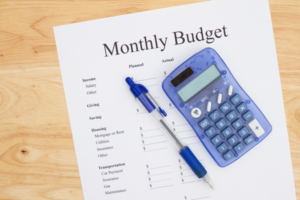A fresh year brings a fresh start, which means that this is a great time to examine your financial goals and expenses for the year. Taking a hard look at your goals for savings, retirement planning, increasing income, and reducing expenses can help you develop a realistic budget plan for 2018 to reach your goals. Not sure how to get started? Read on for quick, actionable tips on how to ensure that 2018 is your healthiest financial year yet.
Savings of all Sizes. When your budget is tight, it’s tough to prioritize your savings. But even setting aside a small amount every week can lead to a major improvement in your financial future. Without a savings cushion to protect yourself, it can be too easy to turn to credit cards to handle life’s emergencies. Work to set aside a small amount of money every week, with the goal of creating an emergency fund of $1,000. To make sure you can stick to your savings plan,  consider setting up automatic transfers so your savings goes out at the same time your income comes in. In addition, try creating a totally separate savings account that is difficult to access (no same day transfers allowed!). This will make you think twice when you try to transfer money into your daily expenses fund. Contact your human resources department and ask if they can split your pay check’s direct deposit into two separate bank accounts. Finally, be realistic about what you can save. If you can steadily save $10 per week, you’ll be in better shape than if you set an unrealistically high goal.
consider setting up automatic transfers so your savings goes out at the same time your income comes in. In addition, try creating a totally separate savings account that is difficult to access (no same day transfers allowed!). This will make you think twice when you try to transfer money into your daily expenses fund. Contact your human resources department and ask if they can split your pay check’s direct deposit into two separate bank accounts. Finally, be realistic about what you can save. If you can steadily save $10 per week, you’ll be in better shape than if you set an unrealistically high goal.
You may feel comfortable with a savings plan of 3-6 months of your expenses. This number will differ for everyone depending on your family’s needs and income, but creating a cushion of this size will allow you greater freedom and prevent you from fearing a sudden job loss or illness.
Increasing Income. What’s a great way to boost your savings? Bring in some extra income each month. Easier said than done, sure, but there are plenty of ways to increase your cash flow. From taking on extra hours at work, to taking on a second part-time job, or even participating in the burgeoning “gig economy” through sharing apps like Uber, even a few extra hours per week can add up. Selling items to consignment shops or online is another quick way to raise some cash, and you can also try using your own social media presence on sites like Facebook or Instagram to share items you’d like to sell with your trusted network of friends and family. Similarly, you can advertise your skills for hire. From cooking to organizing closets to childcare, offering your talents to your network at a fair rate is a great way to earn some money while strengthening your community.
Creating a Budget. The key to creating a budget is having a realistic sense of what you actually need to spend your  money on each month, and how much money you actually have coming in. If your income is variable, try to determine a base level of minimum income and build your budget from there. If you’re not sure how to determine how much money you actually need, first look back over your bank statements from the previous few months. Make clear categories of housing, food, utilities, and other monthly necessities. Then, break down less regular expenses into their monthly amounts. For example, if you purchase oil to heat your home, tally the annual cost and divide it by 12, and set aside the appropriate amount each month so you’re not stuck with a fat bill come wintertime.
money on each month, and how much money you actually have coming in. If your income is variable, try to determine a base level of minimum income and build your budget from there. If you’re not sure how to determine how much money you actually need, first look back over your bank statements from the previous few months. Make clear categories of housing, food, utilities, and other monthly necessities. Then, break down less regular expenses into their monthly amounts. For example, if you purchase oil to heat your home, tally the annual cost and divide it by 12, and set aside the appropriate amount each month so you’re not stuck with a fat bill come wintertime.
Staying Motivated. Personal finance can be challenging, especially when your goals out-pace your ability to meet them. Breaking down goals into smaller parts is the key to staying motivated. For example, if your goal is to create a $1,000 emergency fund, or even a $10,000 savings cushion, breaking that goal down into smaller parts will give you opportunities to celebrate and measure your success along the way. Give yourself quarterly benchmarks to shoot for. If you fall short, don’t beat yourself up. Instead, use the quarterly check-in as a chance to assess whether your goal is realistic and then adjust accordingly. A great way to conduct these check-ins is in writing; start a finance journal in 2018 so you can keep notes on your goals, progress, and your feelings along the way.
By taking just a little time at the beginning of the year to check in with your financial goals, you’ll gain better insight into your true financial soul, and will be better equipped to take the steps you need to build the financial future you deserve.
